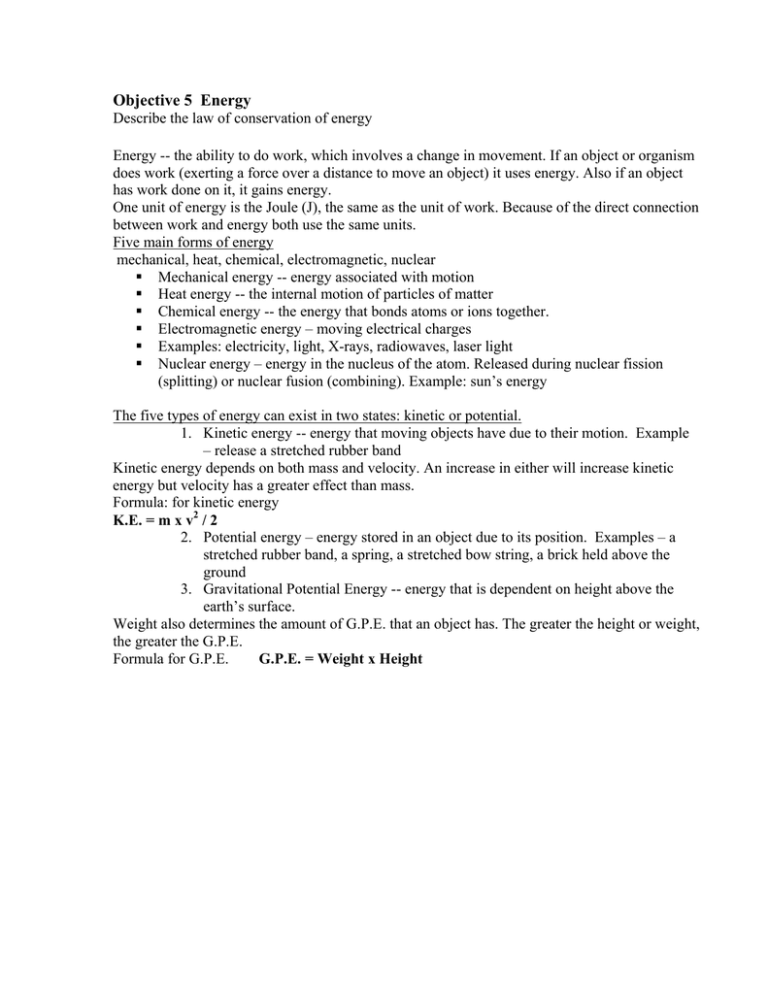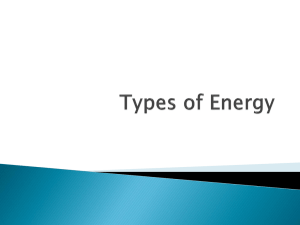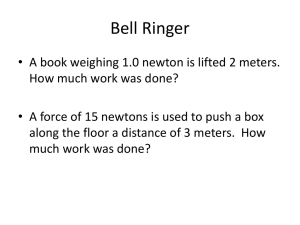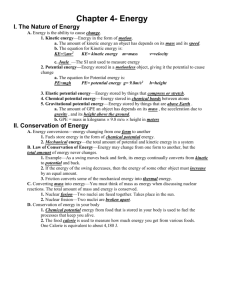Objective 5 Energy
advertisement

Objective 5 Energy Describe the law of conservation of energy Energy -- the ability to do work, which involves a change in movement. If an object or organism does work (exerting a force over a distance to move an object) it uses energy. Also if an object has work done on it, it gains energy. One unit of energy is the Joule (J), the same as the unit of work. Because of the direct connection between work and energy both use the same units. Five main forms of energy mechanical, heat, chemical, electromagnetic, nuclear Mechanical energy -- energy associated with motion Heat energy -- the internal motion of particles of matter Chemical energy -- the energy that bonds atoms or ions together. Electromagnetic energy – moving electrical charges Examples: electricity, light, X-rays, radiowaves, laser light Nuclear energy – energy in the nucleus of the atom. Released during nuclear fission (splitting) or nuclear fusion (combining). Example: sun’s energy The five types of energy can exist in two states: kinetic or potential. 1. Kinetic energy -- energy that moving objects have due to their motion. Example – release a stretched rubber band Kinetic energy depends on both mass and velocity. An increase in either will increase kinetic energy but velocity has a greater effect than mass. Formula: for kinetic energy K.E. = m x v2 / 2 2. Potential energy – energy stored in an object due to its position. Examples – a stretched rubber band, a spring, a stretched bow string, a brick held above the ground 3. Gravitational Potential Energy -- energy that is dependent on height above the earth’s surface. Weight also determines the amount of G.P.E. that an object has. The greater the height or weight, the greater the G.P.E. Formula for G.P.E. G.P.E. = Weight x Height Multiple Choice Identify the letter of the choice that best completes the statement or answers the question. ____ 1.The kinetic energy of an object depends on which of the following? a mass and height c mass and acceleration . . b velocity and height d mass and velocity . . ____ 2.A baseball is dropped from a height of 5 m. As the ball falls toward Earth, there is a decrease in its ____. a gravitational potential energy c chemical potential energy . . b mechanical energy d kinetic energy . . ____ 3. While at a picnic, you place a banana on the ground next to you. The banana has stored ____. a elastic potential energy c chemical potential energy . . b gravitational potential energy d mechanical energy . . ____ 4.A baseball batter hits a pop fly as shown in the illustration. Which of the following energy changes does NOT happen to the ball as it flies through the air? a its mechanical energy increases . b its kinetic energy increases . c its kinetic energy decreases . d its gravitational potential energy increases . ____ 5.A hockey puck gradually slows to a stop as it slides across an ice rink. Which of the following energy transformations occurs? a KE → chemical PE c KE → elastic PE . . b KE → GPE d KE → thermal energy . . ____ 6.A small amount of mass is transformed into energy when ____. a gasoline burns in a car engine . b a nuclear power plant produces electricity . c your body digests a candy bar . d an electric heater warms a room . Table 1 Calories Used in 1 h Body Frames Type of Activity Sleeping Sitting Eating Standing Walking Playing Tennis Bicycling (fast) Running Small Mediu m Large 48 72 84 96 180 380 500 700 56 84 98 112 210 420 600 850 64 96 112 123 240 460 700 1,000 ____ 7.Luis has a medium body frame, and he walks for 30 minutes. How many Calories does he use during this time? Use the table above. a 47 c 210 . . b 105 d 630 . . ____ 8.Chantal eats a burrito that contains 300 Calories. If Chantal has a small body frame, for how long would she have to bicycle at a fast pace to use up the Calories in the burrito? Use the table above. a 12 minutes c 36 minutes . . b 26 minutes d 100 minutes . . ____ 9.A bowling ball rolls at a speed of 2.0 m/s and has kinetic energy of 12.0 J. What is the kinetic energy of the bowling ball when its speed is 1.0 m/s? a 3.0 J c 12.0 J . . b 6.0 J d 24.0 J . . ____ 10.A stone is dropped from a bridge 10 m above a river. Which of the following graphs best represents the mechanical energy of the stone as it falls to a height of 5 m above the river? c a . . b . d . ____ 11.What is the height of a 2.5-kg mass that has gravitational potential energy of 196 J? a 4.6 m c 9.8 m . . b 8.0 m d 78.4 m . . ____ 12.As Joan slides down the slide at the local park, all of the following energy changes occur EXCEPT ____. a GPE → thermal energy c mechanical energy → thermal energy . . b GPE → KE d GPE → chemical PE . . IPC6A Answer Section MULTIPLE CHOICE 1. 2. 3. 4. 5. 6. 7. 8. 9. 10. 11. 12. D A C A D B B C A C B D





